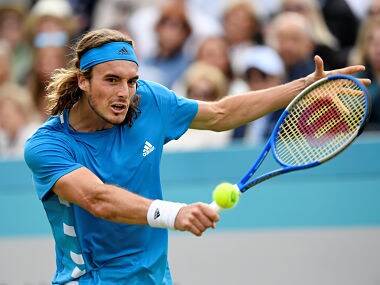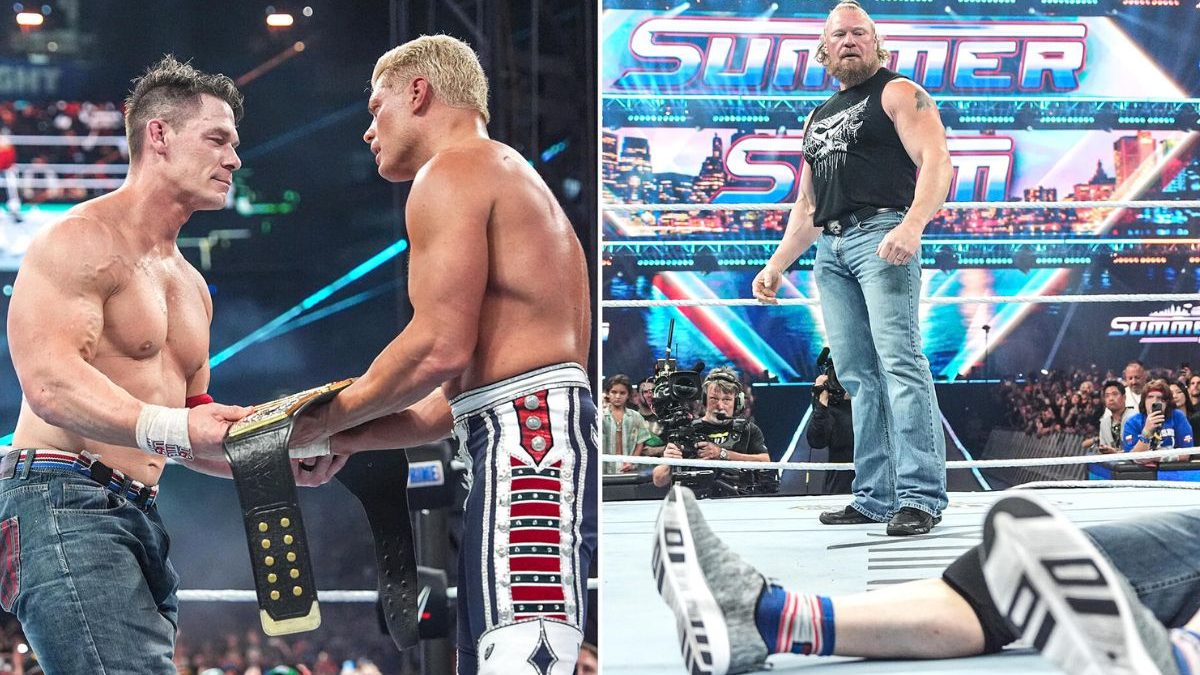During his title run at Halle last week, Roger Federer served his way out of trouble on more than one occasion, reinforcing the importance of a good serve on a quick surface. But there was something else he did that was just as important as those aces and service winners: almost every time he got a ball that was anywhere close to the middle of the court, he took it on the rise, hit it into the corner, and followed it to the net. [caption id=“attachment_6900581” align=“alignleft” width=“380”]  File picture of Stefanos Tsitsipas. Reuters[/caption] Serve and volley may not be the best strategy to win Wimbledon anymore , but grass still rewards attacking play more than any other surface on the tour. Moving along the baseline on grass isn’t as easy as it is on hardcourt or clay; your best bet, therefore, is to move as little as possible. And there’s no better way of doing that than inching forward and taking time away from your opponent – before the opponent can do the same to you. It could be loosely said that the four most important ingredients for success on grass are: 1) the serve, 2) the ability to hit the ball on the rise, 3) the footwork to move efficiently on the slick surface and 4) the attacking mindset to finish points quickly. We know that the Big 3 of Roger Federer, Rafael Nadal and Novak Djokovic have all the four bases covered, which is why they’ve done so well over the years at Wimbledon. But which of the young players – the Next Gen if you will, even if half of them don’t qualify for that moniker anymore – have those qualities too? The first answer that comes to mind is: none. But these players are very young, and their fresh legs could possibly compensate for a shortfall in any of those four factors. And the male player that comes closest to ticking all the boxes is, undoubtedly, Stefanos Tsitsipas. The Greek has had a breakthrough 2019 to say the least. He reached the Australian Open semifinal and played a match for the ages against Stan Wawrinka in the Roland Garros fourth round, while also defeating Federer and Nadal along the way. More pertinently, he has shown off a top-notch net game all year, often surprising his opponents by sneaking into the net and executing an inch-perfect volley. Tsitsipas also has a good serve and is comfortable with his grasscourt movement (you have probably seen those highlight reels of his acrobatic dives on grass), but his ability to hit on the rise from his backhand side is a little suspect. That cost him in the two grasscourt tune-up tournaments at Stuttgart and Queen’s; the 20-year-old lost early in both events as he struggled to control his groundstrokes while going on the attack. But what he may lack technically, he makes up for in intent – especially at the big stage. There’s no young player right now better than Tsitsipas at choosing the right moment to strike a defining blow, and you just know he’ll make a better fist of things in the best-of-five format at the Big W. Tsitsipas starts off against Thomas Fabbiano and could possibly face Ivo Karlovic in the second round and Daniil Medvedev in the fourth, before running into Djokovic in the quarters. That’s not exactly a murderer’s row of opponents in the early going, so he could be in line to make his first ever Wimbledon quarter-final. Speaking of Medvedev, his serve and movement could both be highly effective on grass, and his flat groundstrokes could also do plenty of damage as they skid along the surface. But he has struggled to finish points even when he’s been winning matches by the truckload this season, and David Goffin in the third round might be primed to put paid to the Russian’s Wimbledon aspirations. Felix Auger-Aliassime is also lurking in this quarter; he could face Gael Monfils in the third round and Djokovic in the fourth. The teenage phenom from Canada was appropriately phenomenal in Stuttgart and Queen’s, reaching the final and the semifinal respectively, and his combination of a big serve and bigger forehand seems destined to taste success at Wimbledon some day. Maybe not this year though; Auger-Aliassime had barely played on grass before this year, and best-of-five might be a hurdle too steep for a player just getting to grips with the unique surface. Alexander Zverev and Karen Khachanov are both in the bottom quarter of the top half, and are slated to face each other in the fourth round. Of the two, Zverev seems better-equipped for long-term success on grass; his serve can be almost unbreakable if he’s having a good day, and his backhand can generate effortless power even when he’s digging out low balls. Khachanov, by contrast, takes too large swings on his groundstrokes, without commensurate impact; his roundhouse forehand doesn’t look nearly as deadly as it does on clay or hardcourt. That said, Zverev and Khachanov are both suffering from a bit of a confidence crisis right now, and have shown a disappointing inclination this year to wait for things to happen rather than be attacking and proactive. Zverev looked listless in his losses to Dustin Brown and David Goffin in the lead-up to Wimbledon, while Khachanov’s twin losses to Matteo Berrettini seemed like confirmation that he is destined for a lifetime of middling results on grass. Most would agree that Zverev and Khachanov are trailing Tsitsipas in the expectations-meter at Wimbledon – partly because of their game, but more because of the state of their mind. That was the case at Roland Garros too, but the two defied expectations and finished one round better than the Greek. Will they do that again? Twice in a row might be one time too many. There are plenty of talented youngsters in the bottom half of the draw as well, although none of them seems like a genuine quarter-final contender. 2018 Halle champion Borna Coric has a grasscourt win over Federer on his resume, but the jury is still out on whether he can be assertive enough with his forehand or consistently play inside the baseline. He will likely have another shot at Federer – in the fourth round – so we’ll get a clearer answer about his long-term grasscourt prospects by the second week of the tournament. Denis Shapovalov, the player whose big serve and quick strikes off the ground seem tailor-made for grass, has been far too inconsistent in the last few months for anyone to have major hopes from him. He could play Jo-Wilfried Tsonga in the second round and Nadal in the third; anything beyond that will be an enormous success for the Canadian. Another trio of talented 20-somethings – Frances Tiafoe, Christian Garin and Andrey Rublev – have very tough draws. Tiafoe starts against Fabio Fognini while Garin and Rublev face each other, with the winner likely having to stare down Sam Querrey’s gargantuan serve in the second round. Tiafoe seems to have a good game for grass but Garin and Rublev seem more suited to clay and hard; it would be a surprise if any of them makes the second week. The last name of note in the men’s section, and possibly the most intriguing, is of course Nick Kyrgios. Does he still qualify as a ‘young’ player? It seems like ages ago that he stunned Nadal in the fourth round here to announce his arrival, but he’s still just 24. Kyrgios has gone through a whole world of upheavals since then, and has now come back to square one – he is slated to meet Nadal again, this time in the second round. Which version of Kyrgios will turn up? Will he even get past his first round opponent (Jordan Thompson) to make the blockbuster date with Nadal? We’ve gone past the point of trying to predict Kyrgios’ results, so the best thing to do might be just to wait for the tournament to start. And hope. The new women’s World No 1 is still a ‘youngster’, while history has been made by a teenage qualifier Among the women, we know one young player’s name that is almost guaranteed to achieve Wimbledon success at some point or the other. After Ashleigh Barty’s Roland Garros win, it seems like a matter of time before she repeats the feat at the All-England Club – a place where her big serve, forward-thinking mindset and deft volleys will likely make for a lethal combination. Barty could face Belinda Bencic – another youngster with the tools to do well on grass – in the fourth round, and defending champion Angelique Kerber in the quarter-final. You have to feel good about the Australian’s chances, especially after her win at Birmingham last week. Barty is the new World No 1, and is playing on grass exactly how everyone always expected her to – like an irresistible force. 17-year-old Amanda Anisimova is also in the top half of the draw, and could face two-time Wimbledon champion Petra Kvitova in the third round. Anisimova’s game seems likely to flower on grass at some stage of her career, but 2019 might be too soon; just like Auger-Aliassime on the men’s side, Anisimova hasn’t played much on the surface, and the lack of experience will likely hurt her. What of Naomi Osaka? She’s still just 21, and already seems to have gone through an entire career’s worth of ups and downs. The loss of the No 1 ranking will likely have a positive effect on her though. Shorn of the burden of expectations, she could easily use her flat serve and imposing groundstrokes to take the racquet out of her opponents’ hands. Osaka could face another teenager who made waves at Roland Garros, Iga Swiatek, in the third round, and Dayana Yastremska or Sofia Kenin after that. All three of these players are young, hungry and talented, with the kind of firepower that can earn big rewards on grass. Bold prediction: it could just as easily be one of these three as Osaka in the quarter-finals from this section of the draw. 2017 Roland Garros champion Jelena Ostapenko and 2019 Roland Garros runner-up Marketa Vondrousova also find themselves in this half, and the two are on a collision course in the fourth round. Ostapenko is seemingly the better grasscourter of the two, but her chronic inconsistency means it’s tough to narrow down where she is likely to end up. Something similar can be said about Aryna Sabalenka, another youngster with big weapons and big mental problems. The Belarusian has had a torrid time stringing two good matches together of late, and her draw hasn’t done her any favors: she could face five-time Wimbledon champion Venus Williams in the second round. Of greater interest than that match though is Venus’ first round encounter. She will go up against 15-year-old Coco Gauff, who is the youngest player in the Open Era to qualify for the Wimbledon main draw. Gauff’s journey is unlikely to extend beyond the first round, because Venus is a five-time champion for a reason. But you can bet there will be thousands tuning in to catch a glimpse of the prodigy’s much-talked-about skills in this clash of generations.
Most would agree that Zverev and Khachanov are trailing Tsitsipas in the expectations-meter at Wimbledon – partly because of their game, but more because of the state of their mind.
Advertisement
End of Article


)

)
)
)
)
)
)
)
)



